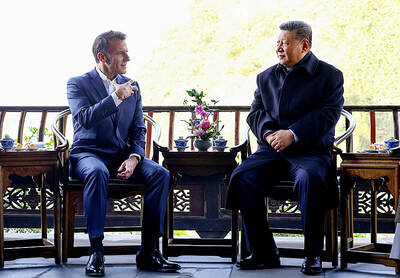For Sale: Part of Grand Teton National Park. Majestic views of the Teton Range. Prime location for luxury resort, home development. Pristine habitat for moose, elk, wolves, grizzlies.
Price: US$125 million. Call: Wyoming Governor Dave Freudenthal.
Wyoming is trying to force the US Department of the Interior to trade land, minerals or mineral royalties for 552 hectares it owns within the majestic park. If the foot-dragging feds don’t agree to a deal — soon — Freudenthal threatens to put a For Sale sign on the property.
Wyoming has owned the land since statehood in 1890, when the federal government set aside land in new Western states to be mined, logged or leased to raise money for public education. Wyoming kept its so-called “school sections” after Grand Teton National Park was established in 1950.
The state has tried for a decade to negotiate some kind of trade.
Saying that his patience is running out, Freudenthal, a Democrat, sent an ultimatum recently to park superintendent Mary Gibson Scott.
“I think he wants to pound the [for sale] sign in himself,” said Ed Grant, director of the Office of State Lands and Investments.
Wyoming gets just US$3,000 a year from the land by leasing it for cattle grazing. Sold with the proceeds invested at 3 percent, the land easily could bring in US$3.75 million a year.
Wyoming’s Constitution requires state officials to manage state lands for maximum profit. Their oaths of office require them to act.
“If it’s to recreate on, or if it’s a new ski lodge, highest and best use,” said Susan Child, deputy director of the state lands office. “It’s obviously not grazing.”
Even in pro-development Wyoming, however, selling off land in a national park isn’t a popular idea. Some are protesting already.
However, Freudenthal, who has a long history of run-ins with the Interior Department over endangered species and snowmobiles in Yellowstone National Park, isn’t stepping on any toes he hasn’t smashed already. What’s more, he’s wrapping up his second term and will leave office next year. He’s all but enshrined as one of the most popular governors in Wyoming history.
“We’re going to continue to push on it,” Freudenthal said. “Somehow we’ve got to get some attention.”
He certainly grabbed the park’s.
“These are wildlife-rich habitats completely surrounded by pristine park land,” park spokeswoman Jackie Skaggs said. “For obvious reasons, Grand Teton National Park would be very, very concerned and disappointed if these lands were sold for development.”
A deal wouldn’t be unprecedented: Utah in 1999 worked out an elaborate swap involving nearly 1,550km² of state land within several national parks, monuments and recreation areas. The state got US$50 million plus 620km² of federal land in return.

A plan by Switzerland’s right-wing People’s Party to cap the population at 10 million has the backing of almost half the country, according to a poll before an expected vote next year. The party, which has long campaigned against immigration, argues that too-fast population growth is overwhelming housing, transport and public services. The level of support comes despite the government urging voters to reject it, warning that strict curbs would damage the economy and prosperity, as Swiss companies depend on foreign workers. The poll by newspaper group Tamedia/20 Minuten and released yesterday showed that 48 percent of the population plan to vote

PARLIAMENT CHAOS: Police forcibly removed Brazilian Deputy Glauber Braga after he called the legislation part of a ‘coup offensive’ and occupied the speaker’s chair Brazil’s lower house of Congress early yesterday approved a bill that could slash former Brazilian president Jair Bolsonaro’s prison sentence for plotting a coup, after efforts by a lawmaker to disrupt the proceedings sparked chaos in parliament. Bolsonaro has been serving a 27-year term since last month after his conviction for a scheme to stop Brazilian President Luiz Inacio Lula da Silva from taking office after the 2022 election. Lawmakers had been discussing a bill that would significantly reduce sentences for several crimes, including attempting a coup d’etat — opening up the prospect that Bolsonaro, 70, could have his sentence cut to

A powerful magnitude 7.6 earthquake shook Japan’s northeast region late on Monday, prompting tsunami warnings and orders for residents to evacuate. A tsunami as high as three metres (10 feet) could hit Japan’s northeastern coast after an earthquake with an estimated magnitude of 7.6 occurred offshore at 11:15 p.m. (1415 GMT), the Japan Meteorological Agency (JMA) said. Tsunami warnings were issued for the prefectures of Hokkaido, Aomori and Iwate, and a tsunami of 40cm had been observed at Aomori’s Mutsu Ogawara and Hokkaido’s Urakawa ports before midnight, JMA said. The epicentre of the quake was 80 km (50 miles) off the coast of

RELAXED: After talks on Ukraine and trade, the French president met with students while his wife visited pandas, after the pair parted ways with their Chinese counterparts French President Emmanuel Macron concluded his fourth state visit to China yesterday in Chengdu, striking a more relaxed note after tough discussions on Ukraine and trade with Chinese President Xi Jinping (習近平) a day earlier. Far from the imposing Great Hall of the People in Beijing where the two leaders held talks, Xi and China’s first lady, Peng Liyuan (彭麗媛), showed Macron and his wife Brigitte around the centuries-old Dujiangyan Dam, a World Heritage Site set against the mountainous landscape of Sichuan Province. Macron was told through an interpreter about the ancient irrigation system, which dates back to the third century